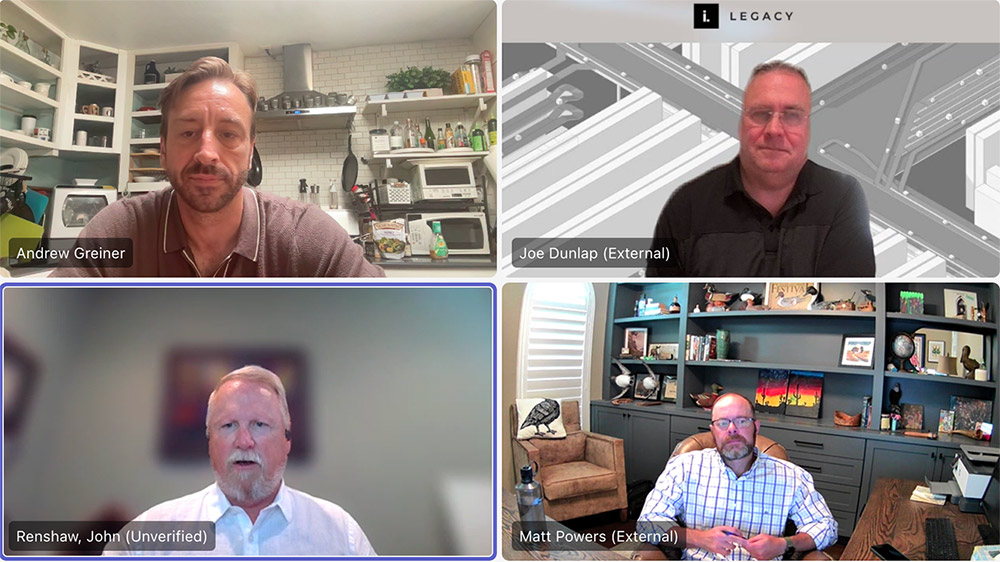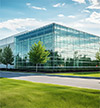We conducted a fascinating discussion with JC Renshaw, Senior Supply Chain Consultant at Savills, Joe Dunlap, Chief Supply Chain Officer at Legacy Investing and Matt Powers, Lead for Site Selection and Supply Chain Strategy Solutions for OnPace Partners, about the current state of rail infrastructure for site selectors.
Area Development: How does access to rail infrastructure influence the overall cost-effectiveness and efficiency of the supply chain?
JC Renshaw: I’ll go ahead and get started in terms of cost effectiveness. First, you have to have a company that's working in the in an industry that would typically utilize rail. And what I mean when I say that is, if you're an e-commerce and you're fulfilling parcels, for example, then rail isn't going to be something that you should tap into. If you're shipping LTL most of the time, rail is not going to be something that you would want to look at. But if you operate in petrochemicals or agriculture or oil, or any number of heavy manufacturing applications, where hoppers are used or where coast to coast transport is used, and time sensitivity isn't quite as much of an issue, more and more clients that we're talking to are looking at rail because of the fact that it's typically a more cost effective solution for them.
The one thing that it also shelters them from is some of the issues that are being experienced with driver shortages. So, with rail transport, you don't have nearly as much labor dedicated to the effort in terms of the actual transit itself. So that provides them, as long as they can communicate effectively with the railroads, in terms of the capacity that is needed, the frequency with which it's needed, the volume that's going to be shipped. It can be a cost-effective solution for them, but to the point I was making earlier, oftentimes it requires the right set of circumstances in order to really tap into the economies of utilizing rail.
Matt Powers: Most of my focus is on retail users and to John's point, a lot of times rail is less of a driver. But at the same time, it's often a plus, less so from e-commerce when you're tackling the major metros, but if you're doing regional distribution plays. I wouldn't say that rail always wags the dog, but at times it does. For instance, when you consider a user like Home Depot or Lowe's, who move a lot of lumber, rail is essential.
BNSF, I talked to those guys a couple of years ago, and one of the things they said, and I wish I had the exact quote that they gave me, but the essence of it was, we just have to sit tight because even if the demand is low today, we know tomorrow it's going to be better. What they're saying is that they've got the infrastructure there. And so if ther is, a lot of concentration or a lot of emphasis around the truck movements, they know in 20 years, things are going to change. And right now they're kind of seeing that, as John mentioned, with driver shortages and things like that. There's more of a push towards rail now even from the retailers. So hey, let's, let's rethink what we're doing. And again, while they're not necessarily needing to go to a real surf site today, it's a plus to know, hey, if in 20 years in the future, things aren't where they need to be. Where we have access to rail, and we can take advantage of it. Another thing I just say, with the fuel offsets, I mean, I think, you know, with rising prices, gas prices, diesel prices, it's, you know, it's beneficial, even for a retailer, to take advantage of rail. You know when it's available.
Joe Dunlap: Is the audience familiar with some of the concepts that we're talking about? Or should we kind of put it in layman's terms?
Area Development Magazine: Oh, layman's terms would be much appreciated.
Joe Dunlap: I wanted to kind of highlight a couple of nuances, maybe, and re-engage with what JC and Matt said. JC, you were talking about outbound for certain industries not being as viable because it's LTL (or e-comm) so the mode doesn't fit, it doesn't match. And I don't know that some audience readers will really capture on that, because a lot of times when, when lay people in real estate talk about rail versus truck, there's this generalization about how rail is, is more cost effective, it's more fuel efficient and the cost per pound, per road mile or rail mile is so much cheaper. But the comparison being used oftentimes is the freight itself, the cargo, the goods, can go either way. And I think what JC was highlighting in that statement was, and Matt said something too about this, if it's lumber for Home Depot or somebody, there are certain goods, especially in this e-comm environment, that we've been growing in the past decade or more, that that freight just not suitable for rail. So the comparison isn't, isn't even one that fits. And I don't know that some people realize that when they're general site selectors, and they don't understand that it's not applicable sometimes.
Area Development Magazine: You guys touched a little bit on some of the selection process and some of labor shortages. Let's bounce down to this one. What about environmental and sustainability benefits that come along with rail?
JC Renshaw: I think Matt made the point in terms of the fuel utilization by going via rail, that the fuel utilization, the carbon footprint and the overarching sustainability factor of rail would have the advantage over putting trucks on the road. So that is an advantage, especially for companies that are tracking their carbon utilization, carbon footprint sustainability initiatives have objectives that they're looking to meet for shareholders and for their board, not to mention some of the other factors, such as the labor shortages that are driving them in that direction anyway, so that they can get two beans in the good jar, if you will, by utilizing rail transportation, by overcoming some of the other obstacles they have, related to carbon footprint and fuel utilization, but then also mitigating some of the issues that they're having related to transportation capacity via other modes.
Joe Dunlap : Yeah, and possibly longer term, some electrification of rail, but I don't think you need it short term to compare to trucking.
Matt Powers: And again, I go back to, with a lot of my clients being retail, that they're much more front facing with their customer group. And I know it may be a little stretch, but beyond what JC and Joe were pointing out, I look at noise pollution, I look at traffic. You know, that's always a pushback from communities. And when you have distribution centers in in the mix, you've got a lot of communities that don't like it, and so oftentimes these rail centers are a little bit removed from that, and so you can avoid, you know, just that PR nightmare by going rail.
Area Development Magazine: You mentioned traffic and there can be a lot of delays with over the road stuff? Do you find that rail helps your clients mitigate delivery delays? Are things running better on time with rail.
JC Renshaw: It's kind of a “it depends” type of situation. If your client deals with one railroad and does not have to change from one railroad to another or transit through many switching yards, it can be reliable. But it's also susceptible to delays. If you were going from Burlington, Northern Santa Fe through to CSX - going through multiple different railroads - you can encounter some issues with time. So, I wouldn't say that it's more dependable. It's better than it used to be, for sure. But each option comes with its own set of challenges. You don't have to worry as much about traffic jams when you're using rail, but you have other circumstances that take place with capacity issues and chassis availability and things like that that can sometimes back up rail yards.
Joe Dunlap: What would you say is the minimum? JC, like anything over three or 400 miles might be eligible to go intermodal to a destination, but beyond, I don't know, 1000 miles, 1200 miles, you run into the higher probability of switching and potential delays, something of that kind of a rule of thumb, right?
JC Renshaw: I would say yes, with one exception to that, one thing that seems to be pretty consistent is that that LA to the northeast transit via rail, that there seems to be a little bit better consistency going literally coast to coast. But if, for example, when Chicago is experiencing capacity and chassis difficulties, things can sit in rail yards for days and weeks on end. Lately, it's been pretty good and consistent and reliable transit from West Coast ports to the northeast part of the country. So that's a very long transit that is typically pretty well priced but also consistent. The others? I absolutely agree with that, Joe.
Matt Powers: I would just add that more sophisticated supply chain users can plan better and so they understand how to take advantage of rail. I would say a lot of your smaller users are still very much dependent upon over the road trucking, just for the fact that they don't have, one, the economies of scale, and two, they just don't have the understanding of how to tackle rail and to plan as well as they should.
Area Development Magazine: Are there any recent developments, innovations or trends that you guys are aware of, that our readers would benefit from?
JC Renshaw: Long trains is one thing. That comes with benefit, but it also is something that's being met with a lot of resistance in a lot of communities because if the fact that if there is just one bridge and you cannot cross it because it is blocked longer train, it's a lot. There are a lot of people that are complaining about the wait times associated with the longer trains. Other things that Joe mentioned, I believe the development of that's currently ongoing, the electric trains, but then also hydrogen power. Some of those things are worth, worth keeping an eye on. I don't know how soon they're going to replace good old diesel, but it's something that's certainly under development.
Joe Dunlap: If you're thinking about other emerging technologies and trends, like a lot of different parts of supply chain, sort of IoT smart sensors, you know, the train industry was probably one of the first to use barcodes, many, many decades ago. So they're no stranger to it. It's just a capital-intensive investment to create additional visibility, transparency of movement of freight and goods for their customers. I was having a discussion with somebody in the industry several months ago, talking about the use of digital twins for preventive maintenance, and how they use that information to predict down times or plan maintenance around certain activities to minimize disruption. So I don't know that we'll see autonomous trains in the same way that we hear so much from some car manufacturers about it, but with some of the accidents that we've seen over the past few years, the idea of putting in sensors and automation to intervene before an accident occurs is likely to be something we hear about in the coming years.
JC Renshaw: That's a good call out. And in terms of autonomous trains, it the benefit isn't there that you see in some of the other modes of transportation, simply because, when you're on a train, you're you have maybe three or four operators on the train. And since Covid, the number has been declining in terms of the number of engineers and the number of railroad employees that are on those trains. So, there isn't as much of an ROI there.
Joe Dunlap: But longer hours and falling asleep at the switch, literally, that could be a bad thing. The business case is potentially there.
JC Renshaw: If you can quantify the safety impact and the risk mitigation and things like that, yes.
Matt Powers: And the No, I think these guys said, I mean, the data mining, the AI, you know, they're all emerging within the industry. I mean having fleet maintenance be more automated, things like that, or train maintenance be more automated. But I would just draw the comparison to say, again, unless you are sophisticated supply chain user, you've kind of got that mindset that it's like hell on wheels or something, you know, name your old, old western train movie. You know, it's like people really, I don't think get that the real industry is staying abreast of what's going on right now.
Area Development Magazine: Great. Can you guys tell talk a little bit about how important it is to collaborate with the rail service providers when you're actually approaching site selection?
JC Renshaw: If you're a volume user, it's if your client or the customer is a volume user. It's very important if, rail is a feasible mode for them to utilize, then you want to ensure that you have the capacity for the volumes that they would be looking at, and that you are working with the we've talked to some clients that are establishing gigafactories and the working with the specific railroads they're actually competing against each other for the business in terms of a site selection, whereby it's the race to see who can dedicate the capacity, provide the infrastructure and provide the pricing All together in order to woo that that Gigafactory to their area, that in combination with economic development incentives and real estate availability, labor and all the other factors that go into site selection,
Joe Dunlap: Maybe one of you guys can use the right terminology here, because I don't have it at the top of my head, But I think it's important for site selectors to understand and collaborate with the rail providers, to understand which rails you can cut a spur into for an industrial park. There are, I think they're called expressways or express lanes, where the trains don't stop, they're moving at a reasonably fast clip, and you can't cut in a spur to get your freight delivered to a factory. So, if having a rail served site is a hard requirement, working with the rail line itself, who can determine which lines can be built off of and which ones can't, may eliminate some sites from consideration. The broader conversation shouldn't really be about one site and site selection, because the justification of building into the rail line, to have a building rail served is almost one of you want to be able to serve a park, an industrial campus of sorts, and not just any one tenant. Otherwise, the timeline and the cost to have a spur built in may kill the opportunity altogether. So there's a lot of time required to go from the concept of site selection and whether I want it to be rail served, and to see it built out if it's not already there.
Matt Powers: And I'm sure you guys have seen it as well. Historically, I would say the major rail lines have been fairly obstinate when it comes to working with them in some ways and trying to make spurs happen and that sort of thing with some generally easier to work with than others. But then short lines, you know, you have much greater flexibility with those guys. You need to understand the short line users, and, you know, building a relationship with the big guys. But I think even a BNSF, they've got a lot more agreeable over the last 10 years or so.
Joe Dunlap: It's not always about being rail served. It could be, you know, site selection relative to an intermodal ramp, that proximity can mean a lot to a client.
JC Renshaw: I absolutely agree with everything these guys are saying. And even there are times that I've seen that a client wanted to move forward without looking at other candidate geographies, they found a building, or their broker found them a building that had a rail spur. And if, if they hadn't done, or we hadn't done for them, the due diligence to find out that that was not an active rail spur and had not been properly maintained, and the railroad would, they were refusing to utilize it. They were not going to serve it, and they were not going to rebuild it. So, it became a worthless rail spur at that location. So, it there's a lot of nuances that can come into play, and a lot of stubbornness, as Matt was saying, that it goes to a number of different elements of the rail industry that there are. There's a lot of cloak and dagger stuff that you don't necessarily get to see the inner workings and the decision-making criteria that go into it. But even pricing is sometimes very difficult to pin down.
Area Development Magazine: Well, I was going to ask about that because, Joe, Joe, you mentioned the high cost of a spur what? What sort of like ballpark are we talking about here? What does it cost to get one?
JC Renshaw: That’s like asking, how much does a house cost? There are a lot of different considerations that can go into that, and I wouldn't want to touch that question, sorry.
Joe Dunlap: I don't think it's cost prohibitive in the grand scheme of things. I think it's jumping through the hurdles, whether it's even feasible from where it is, on the rail line, regulatory or local ordinances that won't allow it, the permitting… Time is money in this case, so if it's a few million bucks, maybe it's 10, 15 million bucks, I don't know that that's really prohibitive. You know, it's more about is it even feasible? So I guess the other thing I was going to add before you jumped in with that question, Andrew, is that it's having this conversation with the level of local understanding for a given rail line. I don't think there's anybody, speaking for myself, I don't think there's anybody that can have that conversation across the entire country and all rail lines. It really requires the local knowledge as well as you know someone that has direct experience with the rail line to validate some of those questions that I'm raising,
Area Development Magazine: Very good. Well, we're coming up to about five minutes left, so maybe one more pass around. What should you, as an executive who's in charge of facility planning and site selection at a corporation, be thinking about, if considering rail, what's, what's one pro and one con for them, possibly.
JC Renshaw: One pro is potentially the cost and the risk mitigation as it relates to other modes of transportation. One con can be the routes that are followed in order to get to the customer, and how many switching yards it has to go through, and if there are changes from one railroad to another, and the potential delays that could be introduced, there are also some other little risks that you don't really think about, such as the ability to stack too high, or the ability to stack three high. If you're coming up from Tijuana into the US, you can only go too high because the tunnels won't accommodate three whereas, if you're coming up from Mexico City through Laredo, you can go three high. So it's just important to look at it from every angle. Consider every mode of transportation and optimize your transportation in order to reduce cost and mitigate risk.
Joe Dunlap: I'll second those. Good job JC, taking the pressure off the rest of us. I think one thing that would be advantageous to think about in terms of the the lane in which you want to move, that freight on rail, is dependency on one rail carrier or one line or one intermodal ramp, or, you know, ideally, if I'm thinking about flexibility and optionality, I would want a location that was dual rail served, meaning that I had multiple rail lines from multiple ports coming to my geography that had different rail carriers so that if one's on strike or there's a outage for some unknown reason that I'm not shut down essentially, or locked in so that I'm forced to move things to road at a much higher expense as my worst case mitigation strategy, but ideally I want to have some optionality with the rail lines as well, and that's a harder ask in some sites, because they don't have dual rail or three different lines coming into them.
Matt Powers: And I just say that the pro right now is, I feel like more so than at least the 20 years that I've been in the business, developers are getting ahead of it and trying to find sites and proximity to rail, trying to line up spurs ahead of time, and so those options are out there. The con to that is it's limited. It's finite, and so there's going to be a lot of competition over the next several years of people gobbling up that space, and then it's just going to be harder to solve the riddle as the years go on.


